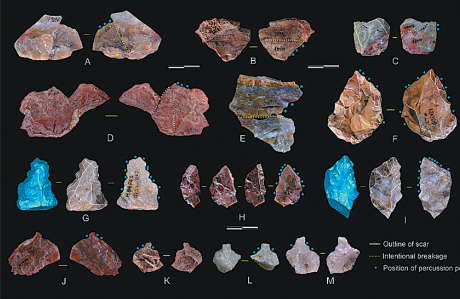China Daily: New findings throw light on tech skills of human ancestors
A new study based on findings at the Nihewan Basin in China's Hebei province reveals that hominins, one of the earliest known ancestors of present-day humans, who possessed advanced knapping or toolmaking abilities, inhabited East Asia 1.1 million years ago. One of the earliest specimens of axes found in the country's Guangxi Zhuang autonomous region was created at least 0.3 million years later.
The toolmaking abilities of the Nihewan Basin hominins were found to match the levels of Acheulean Technology, a prehistoric stone toolmaking strategy with advanced fracture characteristics found in Africa. This suggests that hominins with Acheulean Technology skills dispersed into East Asia much earlier than previously thought, said Ma Dongdong, the first author of the study.
The research was led by Pei Shuwen, a professor from the Institute of Vertebrate Paleontology and Paleoanthropology of the Chinese Academy of Sciences, and Ignacio de la Torre, a professor from the Institute of History at the Consejo Superior de Investigaciones Cientificas or the Spanish National Research Council.
The findings were published in the Proceedings of the National Academy of Sciences, a peer reviewed journal of the National Academy of Sciences, on March 5, providing insights into the early dispersal and adaptions of hominins in Eurasia.
Based on reconstructions made from the refit sets or rearranged products unearthed from the Cenjiawan site of the Nihewan Basin, the research team discovered organized flaking techniques that the hominins used to create tools that could be used for striking or flaking a surface.
Thus there is strong evidence of standardized core preparation. This is characterized by organized methods to obtain predetermined flakes that require in-depth planning and a deep understanding of flaking mechanisms, which originated in the Acheulean or Lower Paleolithic culture in Africa more than 1 million years ago.
Technological analysis of refitted products indicates intentional breakage of slender flakes in two halves, with one or more of the resulting fragments selected as blanks or rough models that could be further processed for retouching, aimed at creating tipped tools with two convergent sides.
In addition, retouching tool patterns that show tool shaping standardization were also well documented in the Cenjiawan findings, which suggests complex mental templates among the Cenjiawan toolmakers, Ma, the author, said.
The prepared core technology, standardized predetermined products, and patterned retouching tool shapes, together with the high level of manual precision and organized management of raw materials documented in the Cenjiawan assemblage, provide compelling evidence of complex technical abilities and in-depth planning behaviors among Early Pleistocene hominins in East Asia, who lived an estimated 2.58 million to 780,000 years ago.
"The advanced technological behaviors documented at the Cenjiawan site are similar to those of Acheulean Technology, rather than the technical simplicity attributed to Oldowan Technology," Pei of the research team said.
Lower Paleolithic technology in China has long been regarded as simple and homogeneous as Oldowan Tools, the universally acknowledged earliest stone tool.
The evidence in the Cenjiawan assemblage provides a new perspective in understanding the technical system or tradition of ancient human stone tool production in North China, and may force a reconsideration of current perceptions, said Pei.
The research team also argued that the technical features, rather than the mere presence or absence of specific tool types, should be the basis for studying Early and Middle Pleistocene assemblages in East Asia.
This enables a more integrated understanding of Acheulean Technology, as well as the human, cultural and biological connections between East Asia and other regions of the Old World, de la Torre said.

Some of the stone tools excavated from the Cenjiawan site of the Nihewan Basin in Hebei province. The hominins who lived in the area more than a million years ago used organized techniques to create tools of various kinds that served specific purposes. CHINA DAILY
Download attachments: